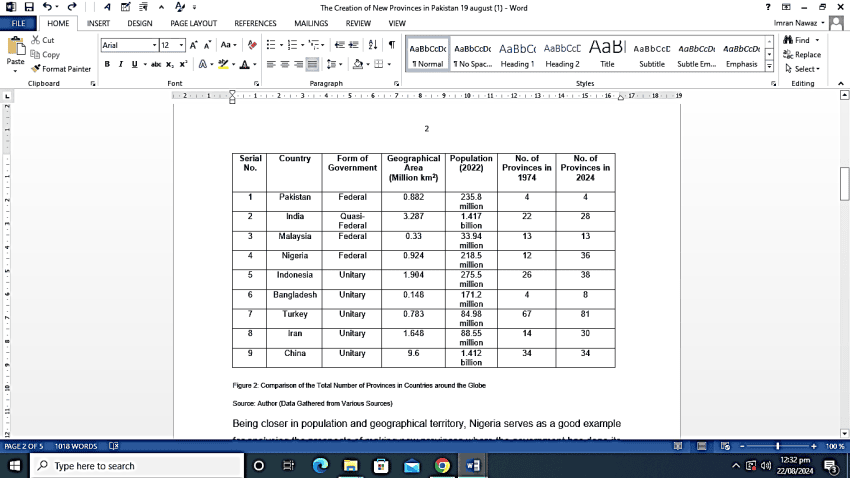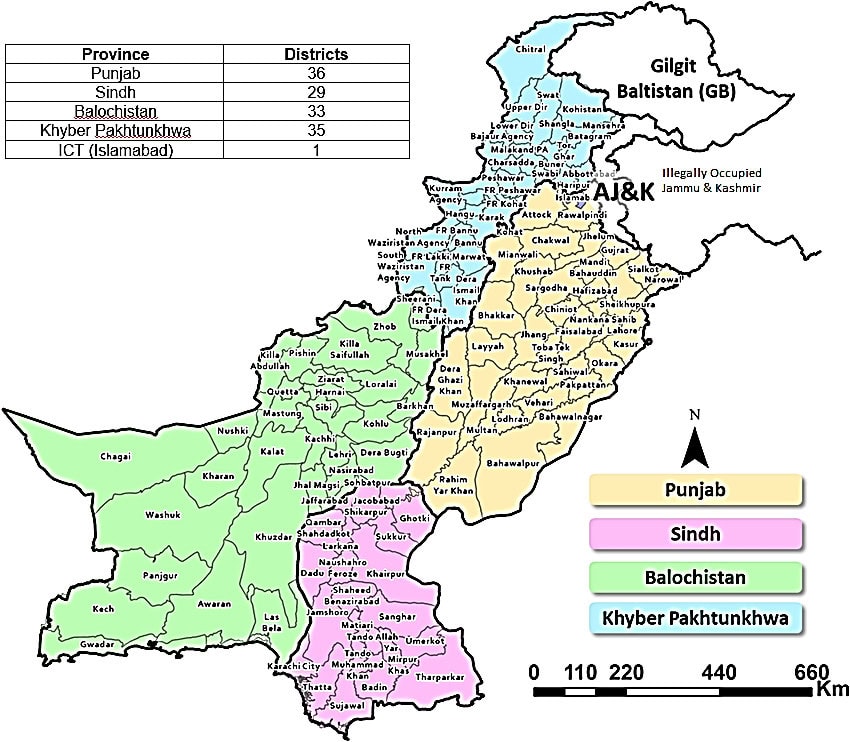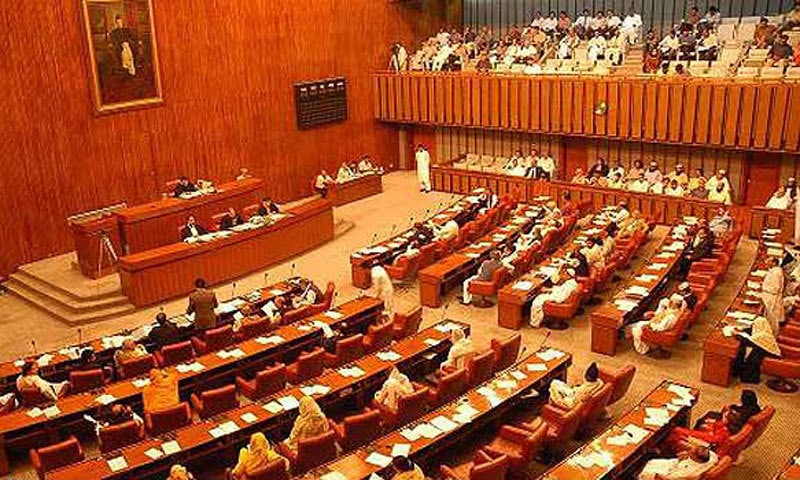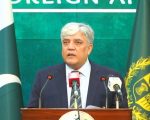Written by: Fatima Saleem
The idea of creating new provinces in Pakistan is not new and has been debated many times. Given the country’s growing population, governing large expanses of geography has become challenging. Hence, smaller administrative units should be established with better local representation.
While some present the proposal’s merits, others believe that carving out new provinces will fuel instability. Opponents of the idea argue that in a resource-stricken, ethnically diverse country like Pakistan, the creation of more boundaries can potentially fuel fragmentation, violence, and ethnonationalism. This insight attempts to address the debate surrounding the creation of new provinces while considering how countries worldwide have benefitted from more provinces.
Figure 1: Comparison of the Total Number of Provinces in Countries around the Globe

Source: Author (Data Gathered from Various Sources)
Figure 2: Map Showing Districts of Pakistan
Source: Research Gate
Pakistan’s government is premised on a federal structure under which the power is distributed between the centre and the constituents. This helps cater to the demands of the country’s heterogeneous and ethnically diverse landscape. On the other hand, in a unitary style of government, the power is concentrated in the centre. Regardless of the type of government, countries continue to create more provinces for efficient delivery of services. Figure 1 shows the provincial evolution of states in the last fifty years:-
Nigeria’s closer population and geographical territory is an excellent example for analysing the prospects of making new provinces. The government has done its utmost to ensure that no single ethnic group dominates any of its states. At its independence in 1960, the country was divided into four regions. However, over time, 36 new states with seven hundred seventy-four local government bodies have been created. According to data, the increased number of administrative units has aided the Nigerian government in improving resource allocation and addressing regional inequalities.
In Turkey, provinces were organised based on historical regions; however, new demarcations have been made based on administrative needs. This has enhanced social cohesion in the country, improved resource management, and increased the responsiveness of its local government.
Having similar government systems, India and Pakistan also hold a resemblance in ethnic and linguistic diversity. Over time, the Indian government has successfully addressed the demand for new states, including the lack of political representation, economic disparity, and development. The following parameters have been considered in the creation of new states in India:-
- Geographic: MP, UP
- Linguistic: South India
- Cultural: Telangana and Andhra
- Historical: Goa
In the last few decades, India has created at least six new provinces to better cater to the needs of its growing population. More provinces/states have helped the Indian government improve its regions’ administration and curb insurgencies and separatist movements. The creation of the States of Chhattisgarh, Jharkhand, and Uttarakhand in 2000 improved local governance and helped these regions’ economic growth.
Globally, no country has a population exceeding 25% of its provinces’ total. In Pakistan, however, the province of Punjab hosts 56% of the country’s population, while Balochistan accounts for a meagre 5%. This has led to uneven resource distribution and unfair political representation in the national legislatures.
Pakistan’s four provinces are divided based on British-era ethnolinguistic divisions, where districts and regions on the peripheries of each are the poorest and rank the lowest in HDI. In addition, due to the sheer travelling distance, the provincial centres remain inaccessible to the locals residing on the fringes of each region, thus making government services unavailable to many. To sum it up, the ineffectiveness of the prevalent governance model, unfair political representation, underdevelopment and the uneven distribution of resources have inculcated in masses a sense of deprivation and deep-rooted grievances.
Ethnicity continues to dominate our political discourse heavily. This has led to politics overshadowing the welfare of the people. In Pakistan, new provinces should be carved out based on the individual needs of each region; however, the most decisive factor in the demarcation of these boundaries should be administrative needs. New provinces can be formed based on geographical configuration, population size, historical and cultural context, economic viability, local security dynamics and ethnolinguistic diversity.
| New provinces will allow efficient administration and better distribution of resources. |
A gradual phase-wise process should be employed to create smaller units. This will give local government more control over finances, thus improving governance and allowing the public greater accessibility to funds and services. This will foster organised development, especially in health care and educational facilities, reassuring the audience about the positive impact of the proposal. Improved administration and enhanced development will help address the locals’ grievances, aiding in quashing militancy.
Considering the advantages of more units, 3-4 provinces can be carved from Punjab and 2-3 from Sindh, KP, and Balochistan. The GB and AJ&K regions can also be made into separate provinces with provisional status. Moreover, given Lahore and Karachi’s economic vitality and population size, the two metropolitan areas can be designated independent metropolis similar to Islamabad. This strategic division can lead to improved governance, better resource allocation, and enhanced local representation, fostering a sense of optimism and hope for the future.
Creating new provinces in an underdeveloped country like Pakistan needs thorough deliberation and the management of political, ethnic, racial, and linguistic differences. An informed debate about the subject needs to be started, engaging all stakeholders and ensuring their voices are heard. Moreover, a roadmap must be devised for its political, administrative, and economic aspects to ensure the proposal stays strong. If implemented, creating new provinces is bound to yield results, strengthen the federation, and promote unity and diversity.
The author can be reached at fatimasaleemraza@gmail.com














